sensor MITSUBISHI ASX 2014 Owner's Manual (in English)
[x] Cancel search | Manufacturer: MITSUBISHI, Model Year: 2014, Model line: ASX, Model: MITSUBISHI ASX 2014Pages: 418, PDF Size: 14.02 MB
Page 15 of 418
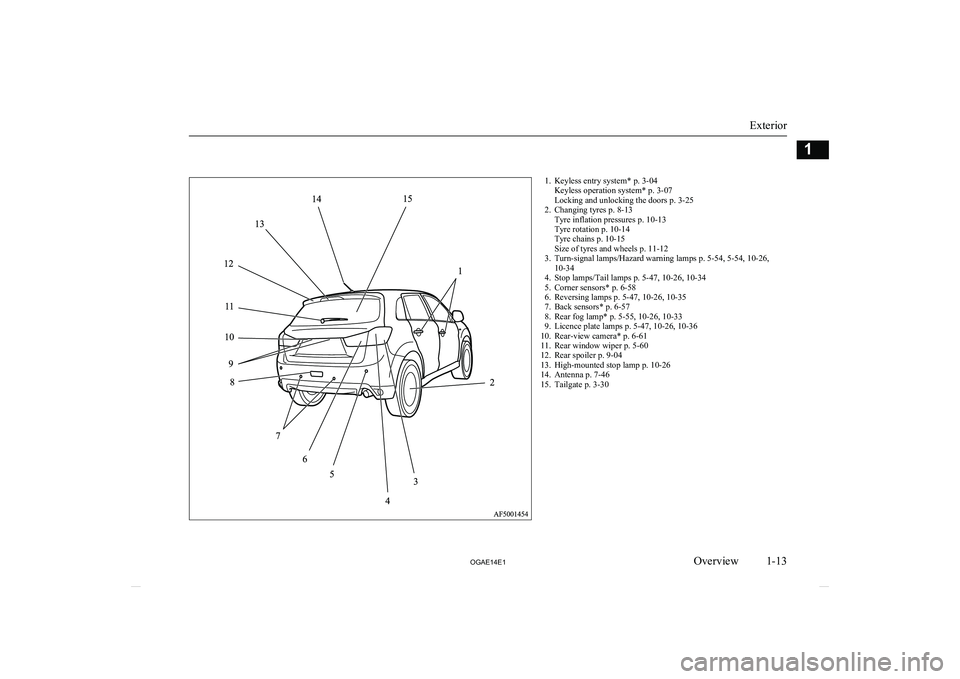
1. Keyless entry system* p. 3-04Keyless operation system* p. 3-07
Locking and unlocking the doors p. 3-25
2. Changing tyres p. 8-13 Tyre inflation pressures p. 10-13
Tyre rotation p. 10-14
Tyre chains p. 10-15
Size of tyres and wheels p. 11-12
3. Turn-signal lamps/Hazard warning lamps p. 5-54, 5-54, 10-26, 10-34
4. Stop lamps/Tail lamps p. 5-47, 10-26, 10-34
5. Corner sensors* p. 6-58
6. Reversing lamps p. 5-47, 10-26, 10-35
7. Back sensors* p. 6-57
8. Rear fog lamp* p. 5-55, 10-26, 10-33
9. Licence plate lamps p. 5-47, 10-26, 10-36
10. Rear-view camera* p. 6-61
11. Rear window wiper p. 5-60
12. Rear spoiler p. 9-04
13. High-mounted stop lamp p. 10-26
14. Antenna p. 7-46
15. Tailgate p. 3-30
Exterior
1-13
OGAE14E1Overview112
3
4
5
6
7
8
9
10 11
12
13
14
15
Page 19 of 418
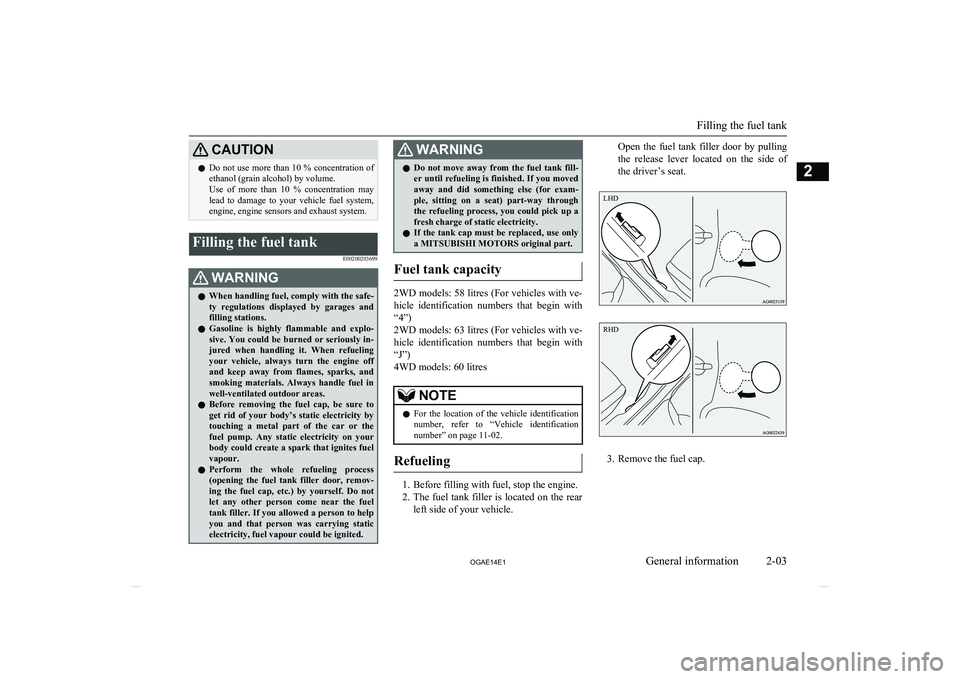
CAUTIONlDo not use more than 10 % concentration of
ethanol (grain alcohol) by volume.
Use of more than 10 % concentration may
lead to damage to your vehicle fuel system,
engine, engine sensors and exhaust system.Filling the fuel tank
E00200203699WARNINGlWhen handling fuel, comply with the safe-
ty regulations displayed by garages and
filling stations.
l Gasoline is highly flammable and explo-
sive. You could be burned or seriously in-
jured when handling it. When refueling
your vehicle, always turn the engine off and keep away from flames, sparks, andsmoking materials. Always handle fuel in
well-ventilated outdoor areas.
l Before removing the fuel cap, be sure to
get rid of your body’s static electricity by touching a metal part of the car or the fuel pump. Any static electricity on your
body could create a spark that ignites fuel vapour.
l Perform the whole refueling process
(opening the fuel tank filler door, remov-
ing the fuel cap, etc.) by yourself. Do not let any other person come near the fuel
tank filler. If you allowed a person to help you and that person was carrying static electricity, fuel vapour could be ignited.WARNINGl Do not move away from the fuel tank fill-
er until refueling is finished. If you moved away and did something else (for exam-
ple, sitting on a seat) part-way through the refueling process, you could pick up afresh charge of static electricity.
l If the tank cap must be replaced, use only
a MITSUBISHI MOTORS original part.
Fuel tank capacity
2WD models: 58 litres (For vehicles with ve-
hicle identification numbers that begin with
“4”)
2WD models: 63 litres (For vehicles with ve-
hicle identification numbers that begin with
“J”)
4WD models: 60 litres
NOTEl For the location of the vehicle identification
number, refer to “Vehicle identification
number” on page 11-02.
Refueling
1. Before filling with fuel, stop the engine.
2. The fuel tank filler is located on the rear
left side of your vehicle.
Open the fuel tank filler door by pulling
the release lever located on the side of
the driver’s seat.
3. Remove the fuel cap.
Filling the fuel tank
2-03
OGAE14E1General information2 LHD RHD
Page 152 of 418
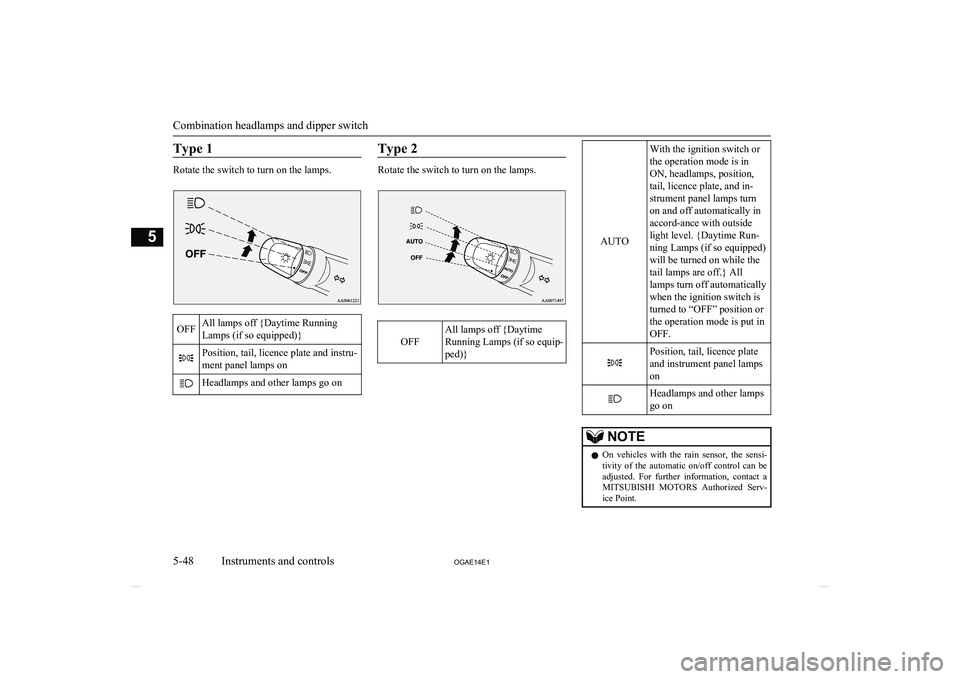
Type 1
Rotate the switch to turn on the lamps.
OFFAll lamps off {Daytime Running
Lamps (if so equipped)}Position, tail, licence plate and instru-
ment panel lamps onHeadlamps and other lamps go onType 2
Rotate the switch to turn on the lamps.OFF
All lamps off {Daytime
Running Lamps (if so equip-
ped)}
AUTO
With the ignition switch or
the operation mode is in
ON, headlamps, position,
tail, licence plate, and in-
strument panel lamps turn
on and off automatically in
accord-ance with outside
light level. {Daytime Run-
ning Lamps (if so equipped)
will be turned on while the
tail lamps are off.} All
lamps turn off automatically
when the ignition switch is
turned to “OFF” position or
the operation mode is put in
OFF.Position, tail, licence plate
and instrument panel lamps
onHeadlamps and other lamps
go onNOTEl On vehicles with the rain sensor, the sensi-
tivity of the automatic on/off control can beadjusted. For further information, contact a MITSUBISHI MOTORS Authorized Serv-
ice Point.
Combination headlamps and dipper switch
5-48 OGAE14E1Instruments and controls5
Page 153 of 418
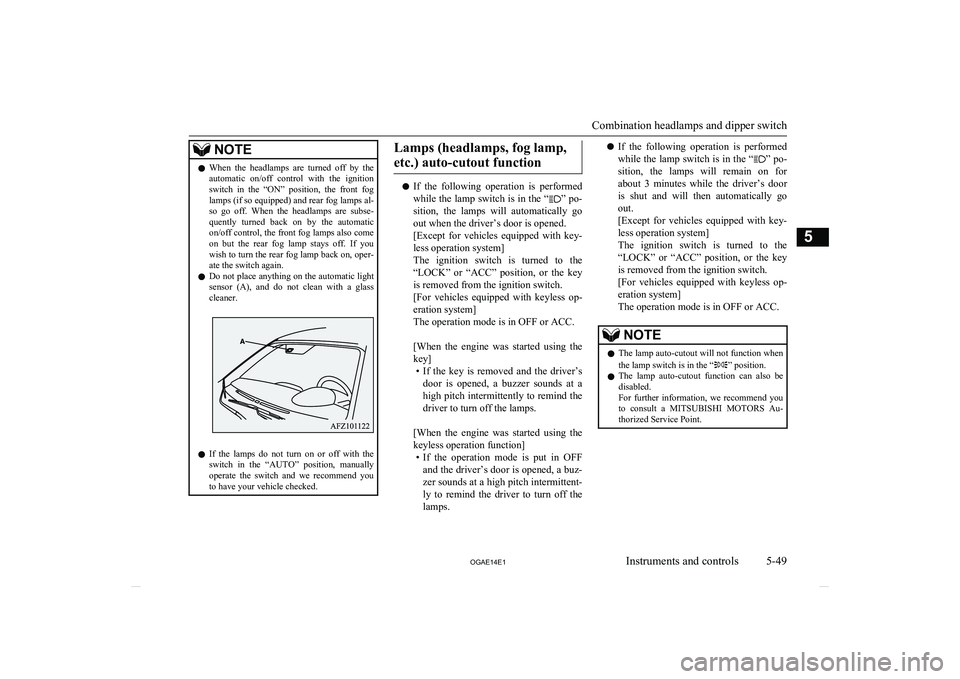
NOTElWhen the headlamps are turned off by the
automatic on/off control with the ignition
switch in the “ON” position, the front fog lamps (if so equipped) and rear fog lamps al-
so go off. When the headlamps are subse- quently turned back on by the automatic
on/off control, the front fog lamps also come on but the rear fog lamp stays off. If you wish to turn the rear fog lamp back on, oper- ate the switch again.
l Do not place anything on the automatic light
sensor (A), and do not clean with a glass
cleaner.
l If the lamps do not turn on or off with the
switch in the “AUTO” position, manually
operate the switch and we recommend you
to have your vehicle checked.
Lamps (headlamps, fog lamp,
etc.) auto-cutout function
l If the following operation is performed
while the lamp switch is in the “” po-
sition, the lamps will automatically go
out when the driver’s door is opened.
[Except for vehicles equipped with key-
less operation system]
The ignition switch is turned to the
“LOCK” or “ACC” position, or the key is removed from the ignition switch.
[For vehicles equipped with keyless op- eration system]
The operation mode is in OFF or ACC.
[When the engine was started using the
key] • If the key is removed and the driver’s
door is opened, a buzzer sounds at a high pitch intermittently to remind the driver to turn off the lamps.
[When the engine was started using the
keyless operation function] • If the operation mode is put in OFF
and the driver’s door is opened, a buz- zer sounds at a high pitch intermittent-
ly to remind the driver to turn off the lamps.
l If the following operation is performed
while the lamp switch is in the “” po-
sition, the lamps will remain on for
about 3 minutes while the driver’s door
is shut and will then automatically go out.
[Except for vehicles equipped with key-
less operation system]
The ignition switch is turned to the
“LOCK” or “ACC” position, or the key is removed from the ignition switch.
[For vehicles equipped with keyless op- eration system]
The operation mode is in OFF or ACC.NOTEl The lamp auto-cutout will not function when
the lamp switch is in the “” position.
l The lamp auto-cutout function can also be
disabled.
For further information, we recommend you
to consult a MITSUBISHI MOTORS Au-
thorized Service Point.
Combination headlamps and dipper switch
5-49
OGAE14E1Instruments and controls5
Page 160 of 418
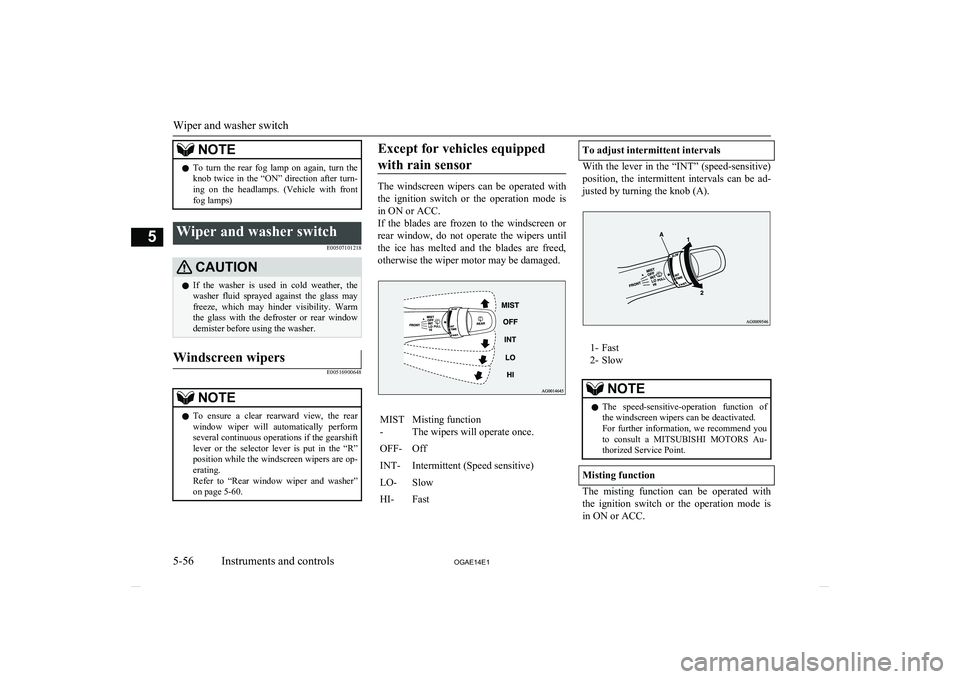
NOTElTo turn the rear fog lamp on again, turn the
knob twice in the “ON” direction after turn-ing on the headlamps. (Vehicle with frontfog lamps)Wiper and washer switch
E00507101218CAUTIONlIf the washer is used in cold weather, the
washer fluid sprayed against the glass may
freeze, which may hinder visibility. Warm the glass with the defroster or rear window
demister before using the washer.Windscreen wipers
E00516900648NOTEl To ensure a clear rearward view, the rear
window wiper will automatically perform several continuous operations if the gearshiftlever or the selector lever is put in the “R”
position while the windscreen wipers are op- erating.
Refer to “Rear window wiper and washer” on page 5-60.Except for vehicles equipped
with rain sensor
The windscreen wipers can be operated with
the ignition switch or the operation mode is in ON or ACC.
If the blades are frozen to the windscreen or
rear window, do not operate the wipers until the ice has melted and the blades are freed,
otherwise the wiper motor may be damaged.
MIST
-Misting function
The wipers will operate once.OFF-OffINT-Intermittent (Speed sensitive)LO-SlowHI-FastTo adjust intermittent intervals
With the lever in the “INT” (speed-sensitive) position, the intermittent intervals can be ad-justed by turning the knob (A).
1- Fast
2- Slow
NOTEl The speed-sensitive-operation function of
the windscreen wipers can be deactivated.
For further information, we recommend you to consult a MITSUBISHI MOTORS Au-
thorized Service Point.
Misting function
The misting function can be operated with
the ignition switch or the operation mode isin ON or ACC.
Wiper and washer switch
5-56 OGAE14E1Instruments and controls5
Page 161 of 418
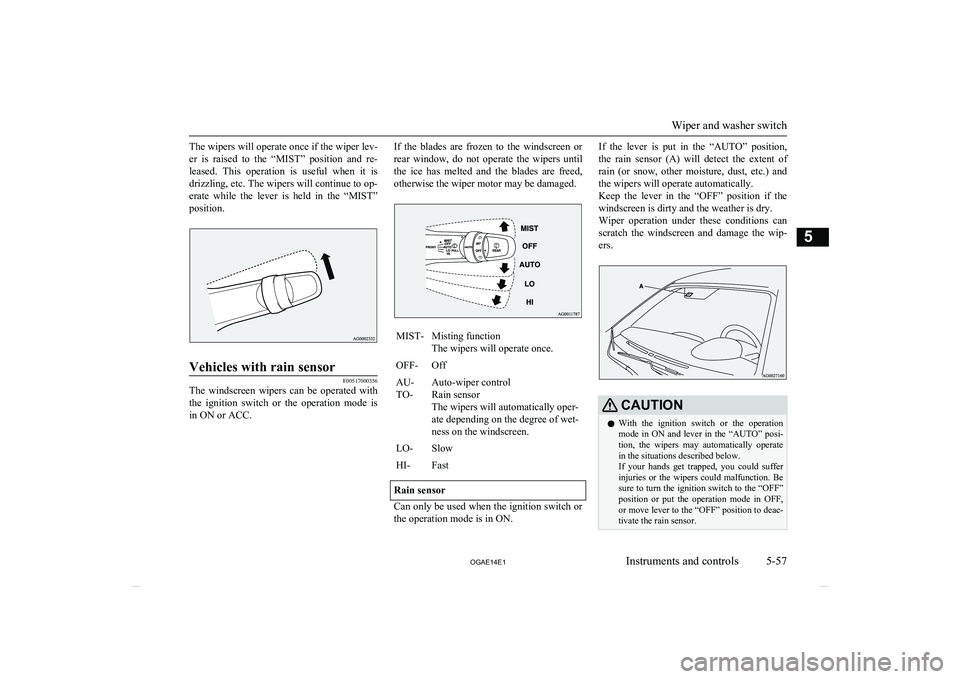
The wipers will operate once if the wiper lev-er is raised to the “MIST” position and re-
leased. This operation is useful when it is drizzling, etc. The wipers will continue to op-erate while the lever is held in the “MIST”
position.Vehicles with rain sensor
E00517000356
The windscreen wipers can be operated with the ignition switch or the operation mode isin ON or ACC.
If the blades are frozen to the windscreen or
rear window, do not operate the wipers until
the ice has melted and the blades are freed, otherwise the wiper motor may be damaged.MIST-Misting function
The wipers will operate once.OFF-OffAU-
TO-Auto-wiper control
Rain sensor
The wipers will automatically oper-
ate depending on the degree of wet-
ness on the windscreen.LO-SlowHI-Fast
Rain sensor
Can only be used when the ignition switch or the operation mode is in ON.
If the lever is put in the “AUTO” position,
the rain sensor (A) will detect the extent of rain (or snow, other moisture, dust, etc.) and the wipers will operate automatically.
Keep the lever in the “OFF” position if the
windscreen is dirty and the weather is dry.
Wiper operation under these conditions can scratch the windscreen and damage the wip-
ers.CAUTIONl With the ignition switch or the operation
mode in ON and lever in the “AUTO” posi-
tion, the wipers may automatically operate in the situations described below.
If your hands get trapped, you could suffer injuries or the wipers could malfunction. Be sure to turn the ignition switch to the “OFF”
position or put the operation mode in OFF, or move lever to the “OFF” position to deac-tivate the rain sensor.
Wiper and washer switch
5-57
OGAE14E1Instruments and controls5
Page 162 of 418
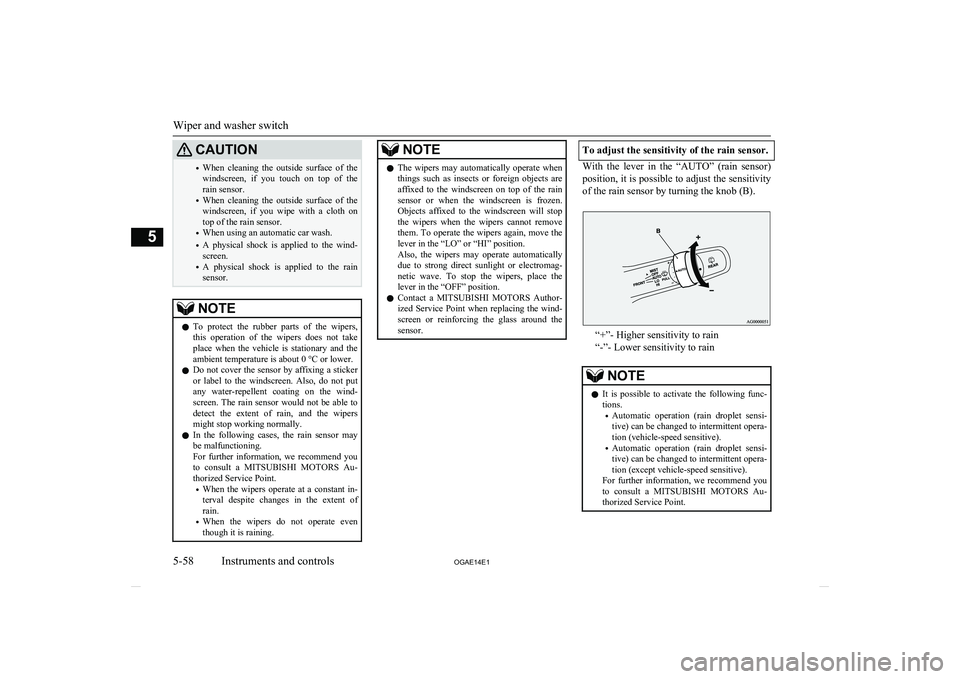
CAUTION•When cleaning the outside surface of the
windscreen, if you touch on top of the
rain sensor.
• When cleaning the outside surface of the
windscreen, if you wipe with a cloth on
top of the rain sensor.
• When using an automatic car wash.
• A physical shock is applied to the wind-
screen.
• A physical shock is applied to the rain
sensor.NOTEl To protect the rubber parts of the wipers,
this operation of the wipers does not take
place when the vehicle is stationary and the
ambient temperature is about 0 °C or lower.
l Do not cover the sensor by affixing a sticker
or label to the windscreen. Also, do not put
any water-repellent coating on the wind- screen. The rain sensor would not be able to
detect the extent of rain, and the wipers might stop working normally.
l In the following cases, the rain sensor may
be malfunctioning.
For further information, we recommend you
to consult a MITSUBISHI MOTORS Au-
thorized Service Point.
• When the wipers operate at a constant in-
terval despite changes in the extent of rain.
• When the wipers do not operate even
though it is raining.NOTEl The wipers may automatically operate when
things such as insects or foreign objects are
affixed to the windscreen on top of the rain sensor or when the windscreen is frozen.
Objects affixed to the windscreen will stop the wipers when the wipers cannot remove
them. To operate the wipers again, move the
lever in the “LO” or “HI” position.
Also, the wipers may operate automatically due to strong direct sunlight or electromag-
netic wave. To stop the wipers, place the lever in the “OFF” position.
l Contact a
MITSUBISHI MOTORS Author-
ized Service Point when replacing the wind- screen or reinforcing the glass around the
sensor.To adjust the sensitivity of the rain sensor.
With the lever in the “AUTO” (rain sensor)
position, it is possible to adjust the sensitivity of the rain sensor by turning the knob (B).
“+”- Higher sensitivity to rain
“-”- Lower sensitivity to rain
NOTEl It is possible to activate the following func-
tions.
• Automatic operation (rain droplet sensi-
tive) can be changed to intermittent opera-
tion (vehicle-speed sensitive).
• Automatic operation (rain droplet sensi-
tive) can be changed to intermittent opera-
tion (except vehicle-speed sensitive).
For further information, we recommend you to consult a MITSUBISHI MOTORS Au-
thorized Service Point.
Wiper and washer switch
5-58 OGAE14E1Instruments and controls5
Page 167 of 418
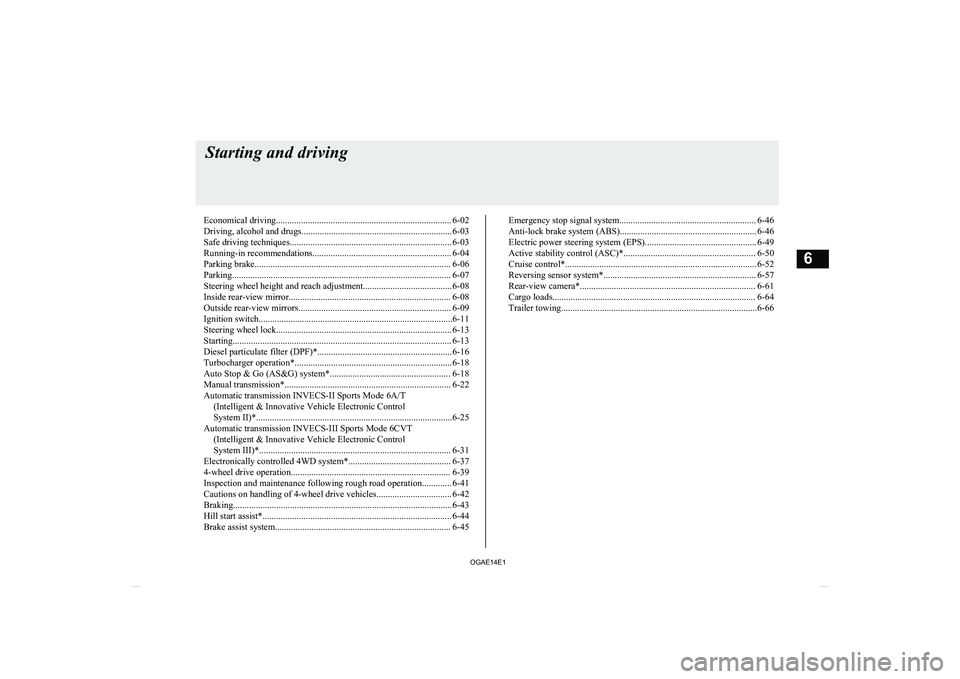
Economical driving............................................................................. 6-02
Driving, alcohol and drugs.................................................................. 6-03
Safe driving techniques....................................................................... 6-03
Running-in recommendations............................................................. 6-04 Parking brake...................................................................................... 6-06
Parking................................................................................................ 6-07
Steering wheel height and reach adjustment....................................... 6-08
Inside rear-view mirror....................................................................... 6-08 Outside rear-view mirrors................................................................... 6-09
Ignition switch.....................................................................................6-11 Steering wheel lock............................................................................. 6-13
Starting................................................................................................ 6-13 Diesel particulate filter (DPF)*........................................................... 6-16Turbocharger operation*..................................................................... 6-18Auto Stop & Go (AS&G) system*..................................................... 6-18
Manual transmission*......................................................................... 6-22 Automatic transmission INVECS-II Sports Mode 6A/T (Intelligent & Innovative Vehicle Electronic Control
System II)*......................................................................................6-25
Automatic transmission INVECS-III Sports Mode 6CVT (Intelligent & Innovative Vehicle Electronic Control
System III)*.................................................................................... 6-31
Electronically controlled 4WD system*............................................. 6-37 4-wheel drive operation...................................................................... 6-39
Inspection and maintenance following rough road operation............. 6-41
Cautions on handling of 4-wheel drive vehicles................................. 6-42
Braking................................................................................................ 6-43
Hill start assist*................................................................................... 6-44
Brake assist system............................................................................. 6-45Emergency stop signal system............................................................ 6-46
Anti-lock brake system (ABS)............................................................ 6-46
Electric power steering system (EPS)................................................. 6-49 Active stability control (ASC)*.......................................................... 6-50Cruise control*.................................................................................... 6-52
Reversing sensor system*................................................................... 6-57 Rear-view camera*............................................................................. 6-61
Cargo loads......................................................................................... 6-64Trailer towing......................................................................................6-66Starting and driving
OGAE14E16
Page 214 of 418
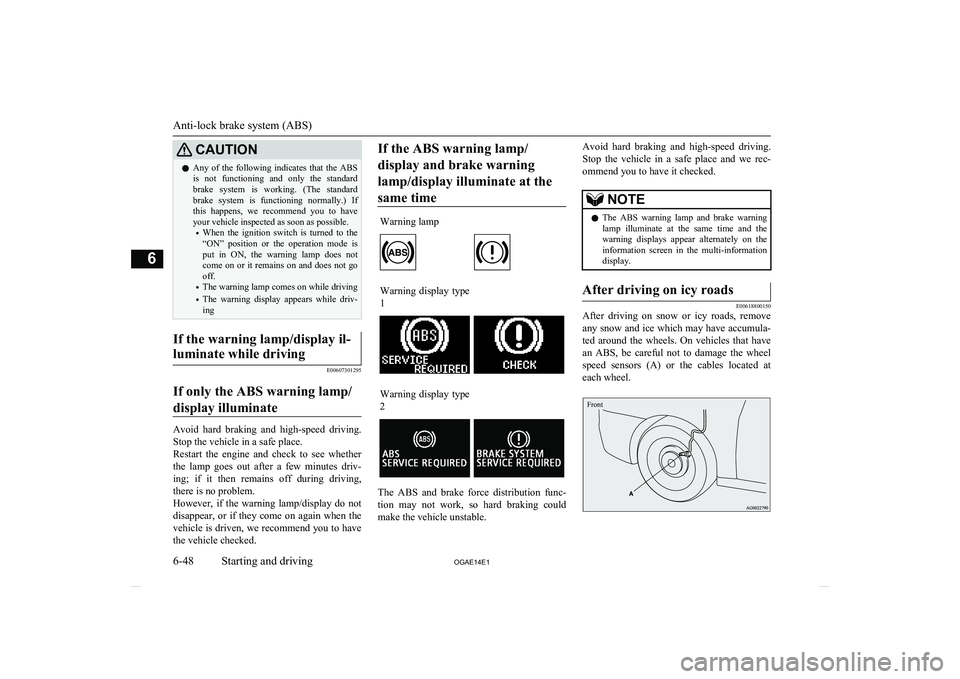
CAUTIONlAny of the following indicates that the ABS
is not functioning and only the standard brake system is working. (The standardbrake system is functioning normally.) If
this happens, we recommend you to have
your vehicle inspected as soon as possible.
• When the ignition switch is turned to the
“ON” position or the operation mode is put in ON, the warning lamp does notcome on or it remains on and does not go
off.
• The warning lamp comes on while driving
• The warning display appears while driv-
ingIf the warning lamp/display il-
luminate while driving
E00607301295
If only the ABS warning lamp/
display illuminate
Avoid hard braking and high-speed driving.
Stop the vehicle in a safe place.
Restart the engine and check to see whether the lamp goes out after a few minutes driv-
ing; if it then remains off during driving, there is no problem.
However, if the warning lamp/display do not
disappear, or if they come on again when the
vehicle is driven, we recommend you to have the vehicle checked.
If the ABS warning lamp/
display and brake warning
lamp/display illuminate at the same timeWarning lampWarning display type 1Warning display type2
The ABS and brake force distribution func- tion may not work, so hard braking could
make the vehicle unstable.
Avoid hard braking and high-speed driving.
Stop the vehicle in a safe place and we rec-
ommend you to have it checked.NOTEl The ABS warning lamp and brake warning
lamp illuminate at the same time and the
warning displays appear alternately on the information screen in the multi-informationdisplay.After driving on icy roads
E00618800150
After driving on snow or icy roads, remove
any snow and ice which may have accumula-
ted around the wheels. On vehicles that have
an ABS, be careful not to damage the wheel
speed sensors (A) or the cables located at each wheel.
Front
Anti-lock brake system (ABS)
6-48 OGAE14E1Starting and driving6
Page 223 of 418
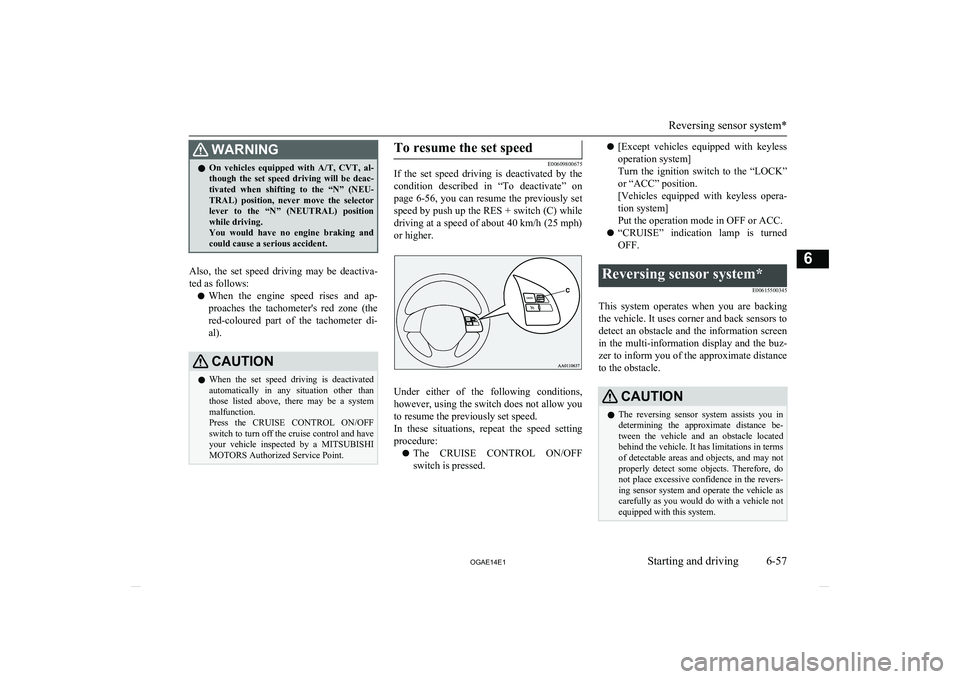
WARNINGlOn vehicles equipped with
A/T, CVT, al-
though the set speed driving will be deac-
tivated when shifting to the “N” (NEU-
TRAL) position, never move the selector lever to the “N” (NEUTRAL) position
while driving.
You would have no engine braking and
could cause a serious accident.
Also, the set speed driving may be deactiva-
ted as follows:
l When the engine speed rises and ap-
proaches the tachometer's red zone (the red-coloured part of the tachometer di- al).
CAUTIONl When the set speed driving is deactivated
automatically in any situation other than those listed above, there may be a systemmalfunction.
Press the CRUISE CONTROL ON/OFF switch to turn off the cruise control and have your vehicle inspected by a MITSUBISHI
MOTORS Authorized Service Point.To resume the set speed
E00609800675
If the set speed driving is deactivated by the
condition described in “To deactivate” on
page 6-56, you can resume the previously set
speed by push up the RES + switch (C) while
driving at a speed of about 40 km/h (25 mph)
or higher.
Under either of the following conditions, however, using the switch does not allow you
to resume the previously set speed.
In these situations, repeat the speed setting procedure:
l The CRUISE CONTROL ON/OFF
switch is pressed.
l [Except vehicles equipped with keyless
operation system]
Turn the ignition switch to the “LOCK”
or “ACC” position.
[Vehicles equipped with keyless opera- tion system]
Put the operation mode in OFF or ACC.
l “CRUISE” indication lamp is turned
OFF.Reversing sensor system*
E00615500345
This system operates when you are backingthe vehicle. It uses corner and back sensors to detect an obstacle and the information screen
in the multi-information display and the buz-
zer to inform you of the approximate distance to the obstacle.
CAUTIONl The reversing sensor system assists you in
determining the approximate distance be-
tween the vehicle and an obstacle located behind the vehicle. It has limitations in terms
of detectable areas and objects, and may not
properly detect some objects. Therefore, do not place excessive confidence in the revers-
ing sensor system and operate the vehicle as carefully as you would do with a vehicle not equipped with this system.
Reversing sensor system*
6-57
OGAE14E1Starting and driving6